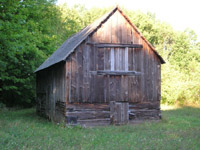Hutzler's Barn
Quick facts for kids |
|
|
Hutzler's Barn
|
|
 |
|
| Location | N of the cemetery, South Manitou Island |
|---|---|
| Nearest city | Leland, Michigan |
| Area | 1 acre (0.40 ha) |
| Built | 1875 |
| Built by | George Johann Hutzler |
| NRHP reference No. | 78000375 |
| Added to NRHP | January 3, 1978 |
Hutzler's Barn is an old farm building. It is located on South Manitou Island. This island is in Lake Michigan, near Leland, Michigan. The barn is the oldest part of George Johann Hutzler's farm.
This barn is important because it helped grow special types of rye and pea beans. These crops won awards! The barn was added to the National Register of Historic Places in 1978. This means it is a special historical site.
Contents
The Story of Hutzler's Barn
Starting a New Life on the Island
George Johann Hutzler was born around 1815 in Bavaria. In 1853, he and his family moved to America. They arrived in early 1854. They first went to Buffalo, New York, to join George's half-brother.
George Johann found work as a sailor. He also worked for a company on South Manitou Island. This company supplied wood to steamships. Around 1860, George moved his family from Buffalo to South Manitou Island.
Farming and Building the Barn
In 1863, Hutzler claimed 160 acres of land on the island. He was the first farmer to do this. He grew crops and raised animals. He built this barn between 1870 and 1880. It was used to house pigs.
George Johann Hutzler died in 1890. He was buried on his farm. His son, John, took over the farm. John was born on the island in 1865.
Growing Special Crops
In the 1920s, scientists from Michigan Agricultural College came to the island. This college is now Michigan State University. They chose South Manitou Island for their plant experiments. The island was perfect because it was far from other farms. This stopped different rye plants from mixing by accident.
Many island farmers, including John Hutzler, helped with these experiments. They worked on new types of crops. These included the award-winning Rosen rye and Michelite pea beans. These crops were once very important in Michigan.
Changes and New Owners
During the Great Depression, it became harder to transport crops. Farmers on South Manitou Island struggled to sell their goods. Even the special experimental farming could not keep the farms going. Because of this, families started leaving the island in the 1940s.
John Hutzler died in 1944. After his death, development groups bought many farms on the island. But their building plans never happened. In the 1970s, the National Park Service bought the Hutzler farm. It became part of the Sleeping Bear Dunes National Lakeshore.
What Hutzler's Barn Looks Like
Hutzler's Barn is in a clear area. The old Hutzler farmhouse and other buildings are also there. The barn is a 2-1/2-story building. It has a gable roof and was used for pigs. It measures about 16 feet by 30 feet. It sits on large wooden beams.
The upper part of the barn was used to store hay. The lower part was for the pigs. The walls are made of old, weathered wood. The front roof is covered with tar paper. Inside, the barn is divided into three sections. Each section has its own entrance.



